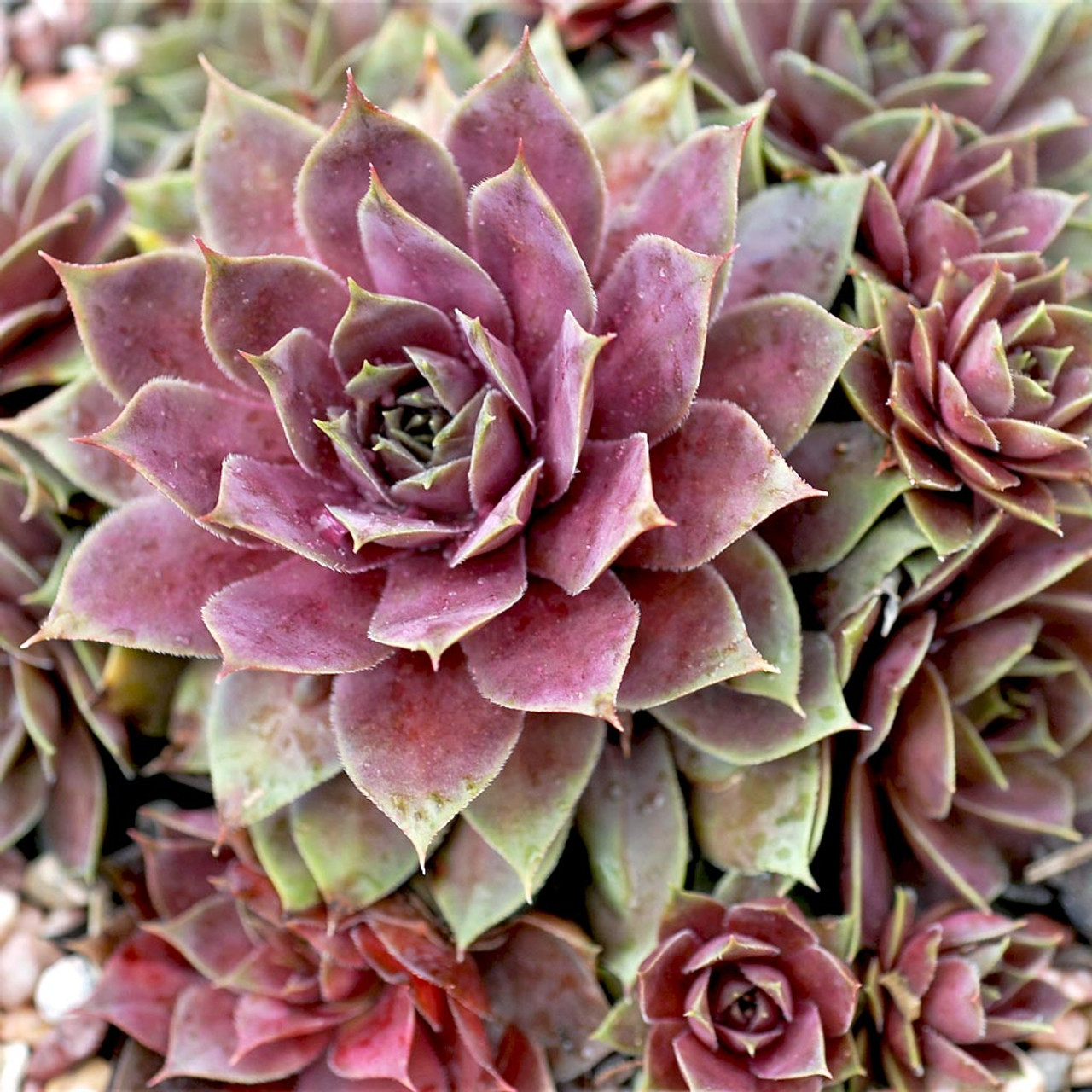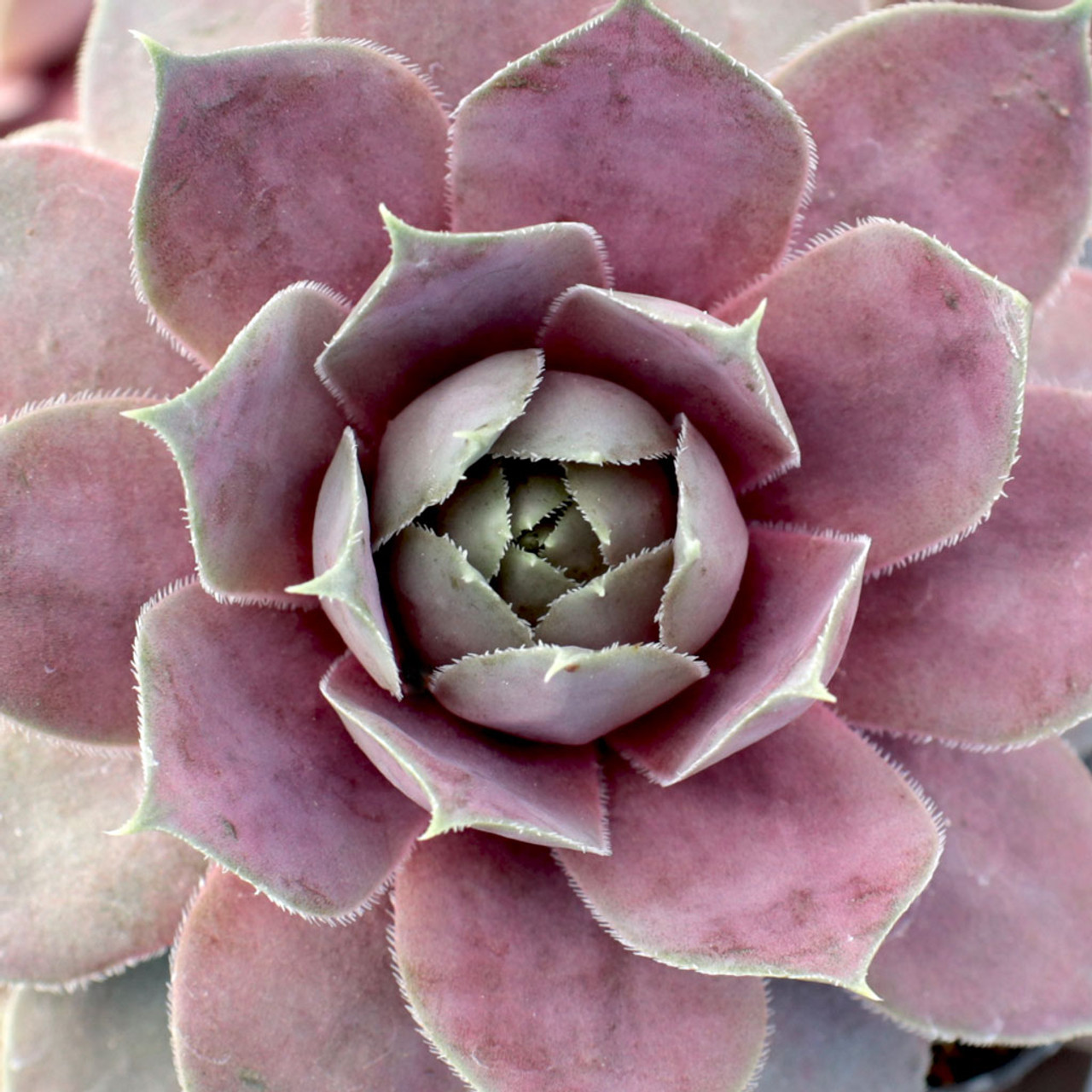This succulent has pink and grey leaves that cluster together in a rosette when exposed to strong sunlight. This particular hybrid is a combination of Sempervivum ‘Lilac Time’ and Sempervivum ‘Jungle Shadows’. It may take several years for the plant to bloom, and it will produce numerous offsets before its death. When it does flower, it will be a beautiful pink hue.
Table of Contents
Care and Propagation Information
Sempervivum ‘Pink Lotus’ will reach its full potential when grown in cooler temperatures or in direct sunlight. It is not attractive to deer, and its blossoms can attract butterflies.
Watering
Sempervivum ‘Pink Lotus’ should be watered with the “soak and dry” technique, in which the soil is allowed to completely dry out between waterings. This is the usual watering requirement for succulents.
This succulent can survive outdoor winter conditions in snowy zones without needing to be watered.
Be sure to get our complimentary watering guide to learn how to recognize when your succulents are being over-watered, and how to take action if necessary.
Where to Plant
The Pink Lotus is quite robust and can survive even in temperatures as cold as -20°F (-28.9°C). It prefers to be exposed to full or partial sunlight and will tend to fade and become tall if grown indoors.
How to Propagate Sempervivum ‘Pink Lotus’
It is very simple to grow more Sempervivum ‘Pink Lotus’. The “hen” (mother plant) will produce several “chicks” (offsets) that can be separated from the parent, put in separate containers, or used in ornamental displays.
Offsets
‘Pink Lotus’ will generate tiny rosette offsets which can be cut away from the main stem using a clean, sharp knife or scissors. Once cut, let the offsets sit for between one and two days before placing them on soil that drains well.
This hybrid will not reproduce true to type if grown from seed.
Practical uses
Care and Propagation Information
General Care for Sempervivum ‘Pink Lotus’
Sempervivum ‘Pink Lotus’ will reach its full potential when grown in cooler temperatures or in direct sunlight. It is not attractive to deer, and its blossoms can attract butterflies.
Watering
Sempervivum ‘Pink Lotus’ should be watered with the “soak and dry” technique, in which the soil is allowed to completely dry out between waterings. This is the usual watering requirement for succulents.
This succulent can survive outdoor winter conditions in snowy zones without needing to be watered.
Be sure to get our complimentary watering guide to learn how to recognize when your succulents are being over-watered, and how to take action if necessary.
Where to Plant
The Pink Lotus is quite robust and can survive even in temperatures as cold as -20°F (-28.9°C). It prefers to be exposed to full or partial sunlight and will tend to fade and become tall if grown indoors.
How to Propagate Sempervivum ‘Pink Lotus’
It is very simple to grow more Sempervivum ‘Pink Lotus’. The “hen” (mother plant) will produce several “chicks” (offsets) that can be separated from the parent, put in separate containers, or used in ornamental displays.
Offsets
‘Pink Lotus’ will generate tiny rosette offsets which can be cut away from the main stem using a clean, sharp knife or scissors. Once cut, let the offsets sit for between one and two days before placing them on soil that drains well.
This hybrid will not reproduce true to type if grown from seed.
Practical uses
Sempervivum ‘Pink Lotus’ is an excellent choice for a living roof as it is a hardy succulent.
FAQ
How many years do succulents live?
Do you cut back Sempervivum?
Sempervivum species do not need to be pruned, however, it is beneficial to snip off any dying flower spikes and cautiously remove any dried, broken, or dead foliage.
What to do with succulents when they get long?
Reworded:
– Take off the leaves. …
– Let the leaves dry out. …
– Transfer the stem to a new pot. …
– Prepare for growth. …
– Spritz the soil until it’s damp, but not soaked. …
– Be patient. …
– Resettle. …
– Lastly, check the roots every half-year to determine if your plants should be transferred to a larger container.
Why is my Sempervivum growing tall?
Consequently, it creates a bigger area for the plant to take in sunlight, making it grow even faster.



